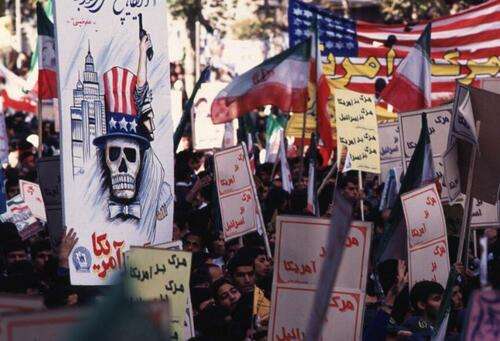Authored by John Rapley via UnHerd.com,
The West’s imperial lifecycle is drawing to a close…
In January 1999, in a Washington of bustling bars and soaring stock markets, Bill Clinton rose to deliver his State of the Union address. America was so untroubled by threat or misfortune that it had spent the previous year debating the precise significance of fellatio. But Clinton, who had survived the scandal, exuded unshakeable personal and civilisational self-confidence. Declaring “a new dawn for America” and a future of “limitless possibility”, he called on Congress to decide how to spend all the record surpluses the government was soon going to enjoy. America’s only inconvenience, it seemed, was too much money. Today, as America struggles to support a crumbling dollar, marshal allies against Russia, ward off a rising China, it’s easy to forget that barely two decades ago it strode the planet like a colossus.
But pride before a fall has an ancient lineage, and only the arrogance of the historical present could treat American imperial decline as a novel phenomenon, let alone mere metaphor. Some 16 centuries before Clinton, in an uncannily similar setting of domes and colonnades, a Roman orator stood before the imperial Senate to deliver an equally triumphal speech. It was 1 January 399, inauguration day for the latest in a millennium-old line of consuls, the most prestigious Roman office. This year’s candidate was Flavius Mallius Theodorus. After rising to praise his audience — “here I see gathered all the brilliance of the world” — he went on to proclaim the dawn of a new Golden Age, celebrating the unparalleled prosperity of the Empire.
Rome’s rapid comeuppance is now a historical parable that America can learn from in real-time. Because the rhetoric of Clinton and his ancient predecessor was spoken from atop the crest of the same wave: an identical process of rise and decline which Peter Heather and I, in our new book, call “the imperial lifecycle”. Empires grow rich and powerful and attain supremacy through the economic exploitation of their colonial periphery. But in the process, they inadvertently spur the economic development of that same periphery until it can roll back and ultimately displace its overlord.
America has never thought of itself as an empire, mainly because with the exception of the few islands in the Pacific and Caribbean, it has never accumulated a large network of overseas territories. But this modern European model, in which colonies were (and in a few cases, still are) administered by governors who answered directly to the imperial capital, was but one of many. The late Roman Empire, for instance, functioned as an “inside-out” empire — effectively run from the provinces, with Rome serving more as a spiritual than administrative capital. What held it all together was the shared culture of the provincial nobility that ran it, most of whom has provincial origins but had been socialised into what Peter Heather has called the imperial culture of “Latin, towns and togas”.
The American Empire — or more accurately the American-led Western empire — mirrors this confederal model, with an updated cultural-political glue that we might call “neoliberalism, Nato and denim”. Under this regime, the nation-state was primary, borders were inviolable, relatively open trade and capital movement prevailed, governing elites were committed to liberal principles, and bureaucracy was based on increasingly standardised education systems (with economics training assuming an increasingly central role as the century progressed). But since its establishment in 1944 at the Bretton Woods conference, its fundamental economic model has been in the timeless imperial mould: exploitation of the periphery to the benefit of the imperial core.
The great wave of decolonisation that followed the war was meant to end that. But the Bretton Woods system, which created a trading regime that favoured industrial over primary producers and enshrined the dollar as the global reserve currency, ensured that the net flow of financial resources continued to move from developing countries to developed ones. Even when the economies of the newly-independent states grew, those of the G7 economies and their partners grew more. And while the treaty arrangements that cemented this system were periodically updated at international summits, even then the US and its main trading partners would typically draft a deal for sign-off by everyone else. As a result, the gap between rich and poor countries grew bigger than ever.
Clinton was speaking at the all-time peak of this American imperial order. Two years earlier, a financial crisis that had begun in Asia had ricocheted across the developing world. And when protesters filled streets and governments across the Global South collapsed, the rich in developing countries panicked and sent their money into the safe haven of US Treasury paper. That influx of cash sent the late Nineties US economy into overdrive, creating the abundance that Clinton took to be endless.
In fact, as he was speaking, the overall flow of global capital had already begun moving the other way. By this time, quietly but steadily, developing countries like China and India had shaken off the torpor of earlier decades and were starting to grow in leaps and bounds. The brief recessions induced in developing countries by the Asian Crisis and the consequent boom in the West obscured the fact that the really dynamic economies of the world were now in what was called the Third World. Once the protests died down and normal business resumed there, investors in the developing world — followed by fund-managers in Western countries — sent their money back to the growing economies of the global periphery.
In the Roman Empire, peripheral states developed the political and military capacity to end Roman domination by force. In the modern case, the conflict was fought through diplomatic, economic and political channels. The year of Clinton’s panegyric now looks pivotal — not only for the changing capital winds, but because of what happened at that year’s World Trade Organization summit in Seattle. After decades in which they’d more or less signed off on done-and-dusted deals, delegations from some of the big developing countries got together, refused to go along and brought the negotiations to a halt. As their diplomatic and political capacity rose to match their economic heft, developing countries were now demanding, and getting, better deals.
The Third World was rising, and it quickly showed in the economic data. On the eve of the millennium, the cusp of its supremacy — a supremacy no other empire in history had come remotely close to matching — the West accounted for four-fifths of the global economy. Today, that’s down to three-fifths, and falling. The fastest-growing economies in the world are now all in the old periphery; the worst-performing economies are disproportionately in the West. These are the economic trends that have created our present landscape of superpower conflict — most saliently between America and China. A once-mighty empire is now challenged and feels embattled. Taken aback by the refusal of so many developing countries to join in isolating Russia, the West is now waking up to the reality of the emerging, polycentric and fluid global order.
These trends are only set to continue. But this is where America and Rome diverge. The Roman Empire existed at a time where there was one fixed factor of production: land. The economy was therefore necessarily steady-state and overwhelmingly agricultural. For the periphery to rise, the core had to fall, as the barbarian invaders seized physical Roman real estate. But in the modern world, where continued technological progress means economies can keep moving forward, if more slowly, decline may only need to be relative. The West can continue to grow, and to play a pre-eminent role in global governance.
But meek acceptance isn’t what builds empires in the first place. The danger is that, obsessed with past glories and tempted by a desire to turn back the clock, Western countries attempt to restore their greatness. Since its own imperial marginalisation, Britain has been possessed by a manic and counter-productive declinism, most recently responding to the 2008 crash with a programme of austerity that has sunk its economy into what may become a permanent decay. America’s interminable annual wranglings over debt ceilings could, if they continue, diminish the attractiveness of the dollar, at a time when developing countries are looking for alternatives.
The fate of the West hangs in the balance, and it must stop drawing the wrong lessons from Roman history, not the least of which is a stubborn refusal to accept a diminished role in its world. After all, the Roman Empire might have survived had it not weakened itself with wars of choice on its ascendant Persian rival. By finding a way to coexist peacefully with its own rival China, however uncomfortable that may be, the US could do itself and the world a favour.








